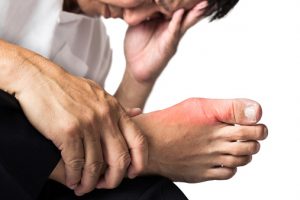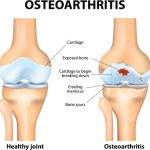 Gout and osteoarthritis are both uncomfortable conditions that come with joint pain and swelling, but they are two distinct problems that require specific treatment. See Gout vs Osteoarthritis comparison table.
Gout and osteoarthritis are both uncomfortable conditions that come with joint pain and swelling, but they are two distinct problems that require specific treatment. See Gout vs Osteoarthritis comparison table.
Osteoarthritis is a joint disease that impacts the tissue covering the ends of the bones in a joint. Most people know this tissue as cartilage. When we have healthy cartilage, it allows our bones to glide over each other and it helps absorb shock from movement. When someone has osteoarthritis, the top layer of the tissue wears away and the bones underneath rub together. This rubbing leads to pain and swelling. Although a form of arthritis, gout is primarily characterized by redness and pain in the joint at the base of the big toe.
Advertisement
Close to 30 million Americans suffer from osteoarthritis, while gout affects over 8 million Americans. Osteoarthritis is common among the elderly, although younger people can get it. Gout is most common in men.
Osteoarthritis prevalence, severity higher in older men with gout
A study published in Rheumatology suggests that osteoarthritis is more prevalent among older men who have gout.
Researchers looked at 75 men between the ages of 55 and 85 who had gout – 25 had asymptomatic hyperuricemia, a condition that puts you at a higher risk for gout, and 25 had neither. Patients with inflammatory arthritis, inflammatory bowel disease, total knee replacement, or history of severe knee traumas were excluded.
Diagnosis was determined using a measurement set out by the American College of Rheumatology known as the Kellgren-Lawrence grading. Uric acid levels were also measured during visits with each participant. Gout occurs when the body forms crystals of uric acid. Uric acid is a substance that usually dissolves in the blood and then passes out of the body in urine. When these crystals build up in specific joins, it causes pain. Large buildups of crystals that can look like a lump under the skin are called tophi.
In the end, the assessment and comparison showed that osteoarthritis among older men with gout was more prevalent and more severe than those without gout.
The similarities between gout and osteoarthritis are mainly the joint pain and stiffness. While both conditions involve inflammation and come with periods of fatigue, there are many differences.
Comparison table: Gout vs Osteoarthritis
| Gout | Osteoarthritis | |
|---|---|---|
| Overview | Redness and pain in the joint at the base of the big toe. | Impacts the tissue covering the ends of the bones in a joint. |
| Prevalence | Varies between populations. | 68% of women and 58% of men over the age of 65. |
| Gender | More common in men and in women after menopause. | Before 50 more men than women, after 50 more women than men. |
| Symptoms | Joint pain usually around the big toe, joint discomfort, inflammation and redness, extreme tenderness, limited range of motion, development of tophi possible. | Joints painful (without swelling), affects joints asymmetrically, bigger joints such as hips & knees. |
| Causes | Occurs when urate crystals accumulate in your joints causing the inflammation. | Occurs when the cartilage that cushions the ends of bones in your joints gradually deteriorates. |
| Affected body parts | Joint of the big toe most commonly affected. Ankle, heel, knee, wrist, fingers, and elbow are also affected. | Finger joints closest to the fingernails or the thumbs, weight-bearing joints. |
| Complications | Recurrent or advanced gout, kidney stones. | Severe joint pain and stiffness, some people are no longer able to work. |
| Diagnosis | Imaging tests, drawing fluid from the swollen joint for analysis, blood tests. | X-ray, pain assessment, presence of deformity, evidence of muscle wasting, local inflammation. |
| Treatment |
|
|
| Speed of onset | Sudden onset, often during the night. | Slow, over years. |
Difference between gout and arthritis. Download comparison chart (JPG)
Gout and osteoarthritis characteristics
The difference between gout and arthritis starts with the cause. It becomes confusing to some people because the term “gouty arthritis” is often used to describe uric acid buildup in the joints. However, typical arthritis or osteoarthritis is normally caused by aging, injury, wear and tear, or it is a hereditary factor. On the other hand, it is uric acid crystals that cause gout, not aging or typical tissue wear and tear.
Doctors classify gout as a metabolic disease. This means that a set of risk factors may exist within a person’s body that could make them more prone to the particular ailment. This is not always the case with osteoarthritis, since it can be due to normal wear in the joints. When a person gets osteoarthritis, they do not experience chills and mild fever like people with gout can.
Here are some other differences:
Diagnosis
- Gout – imaging tests, drawing fluid from the swollen joint for analysis, blood tests.
- Osteoarthritis – x-ray, pain assessment, presence of deformity, evidence of muscle wasting, local inflammation, asymmetrical joints.
Joint symptoms
- Gout – arthritic joint pain, swelling, redness, warmth, and extreme tenderness. Development of tophi possible. Acute onset more common.
- Osteoarthritis – joints painful but without swelling, affects joints asymmetrically, affects bigger joints such as hips & knees.
Gender
- Gout – more common in men and in women after menopause.
- Osteoarthritis – experienced by both men and women. Before 50 more men than women, after 50 more women than men.
Pattern of joints affected
- Gout – joint of the big toe most commonly affected. Ankle, heel, knee, wrist, fingers, and elbow are also affected.
- Osteoarthritis – asymmetrical, can possibly spread to the other side. Symptoms begin gradually and are often limited to one set of joints – usually the finger joints closest to the fingernails or the thumbs, as well as large weight-bearing joints.
Gout and osteoarthritis treatment options
 Gout can be serious if it goes untreated. It can lead to the destruction of joint surfaces and cause joint deformity, as well as tophi – the buildup of painful uric acid crystals in the joint. Gout medications can be used to treat attacks and to prevent future episodes, including the development of tophi.
Gout can be serious if it goes untreated. It can lead to the destruction of joint surfaces and cause joint deformity, as well as tophi – the buildup of painful uric acid crystals in the joint. Gout medications can be used to treat attacks and to prevent future episodes, including the development of tophi.
Some doctors will prescribe their gout patients nonsteroidal anti-inflammatory medications to help calm the inflammation and pain, but there are also medications designed specifically for gout pain. Corticosteroids are also used to treat gout.
When gout attacks are frequent, doctors may suggest medications that block uric acid production. There are also treatments that will improve uric acid removal from your body, but it is important to review the possible side effects of these medications with your doctor.
Osteoarthritis treatment comes in the form of both medications and exercise. Pain and anti-inflammatory medications are prescribed to some osteoarthritis patients. As well, many who suffer from the condition have been known to experience great relief from gentle exercise, such as stretching. Yoga and tai chi are examples of exercises that improve joint flexibility, ease stiffness, and reduce pain. Working with a physical or occupational therapist has been very helpful for some people with osteoarthritis.
Gout and osteoarthritis home remedies and prevention
If you are prone to gout, there are ways you can safely avoid having another attack. For instance, studies show there is a link between gout and food, so the following tips might be helpful.
- Limit or avoid alcohol – studies show beer is particularly likely to increase the risk of gout in men.
- Limit your intake of meat, fish, and poultry – a small amount may be okay, but too much may cause a flare-up.
- Maintain a good body weight – losing weight can lower uric acid levels. Avoid fasting though, since it can temporarily raise uric acid levels.
- Maintain good fluid intake – it is important to stay hydrated, especially with water.
There are lifestyle changes you can make to address osteoarthritis, too. For example, obesity is considered a risk factor for osteoarthritis, so maintain a healthy lifestyle that includes a good diet and regular exercise.
If you are afraid of joint pain due to exercise, try heat or cold on your joints to take away the discomfort. It will make it a lot easier to stay active. The safe exercises are ones that place the least amount of body weight on the joints. These include swimming and cycling.
Advertisement
One group of researchers have estimated that overweight women who lost 11 pounds (about two body mass index points), decreased their risk of osteoarthritis by more than 50 percent. A comparable weight gain has been associated with an increased risk of developing osteoarthritis in the knees.
Here are some other ways you may be able to keep osteoarthritis at bay:
- Keep blood sugar under control – studies show diabetes may be a risk factor for osteoarthritis.
- Play safe – not all accidents are avoidable, but protective gear when playing sports will go a long way in helping shield joints from damage.
- Warm up – don’t forget to do warmup exercises before engaging in physical activity.
- Practice proper bending – avoid bending knees past 90 degrees when doing half-knee bends.
- Eat right – certain nutrients, including Omega-3 fatty acids, vitamin C, and vitamin D are thought to be good preventative nutrients when it comes to osteoarthritis.
The American Council on Science and Health recently reported that joint-related diseases are on the rise and that lifestyle choices may be the over-riding reason. While there are many aspects of life we do not have control over, lifestyle is something we can control. Both gout and osteoarthritis puts a tremendous burden on not only the person who is suffering from the disease, but on the healthcare system as well. Between 2007 and 2012, in just one U.S state, emergency room visits due to joint pain such as gout and osteoarthritis went up over 30 percent. Experts say proper treatments that also include lifestyle adjustments should be able to lessen the number of ER visits, while they continue to look for cures.
